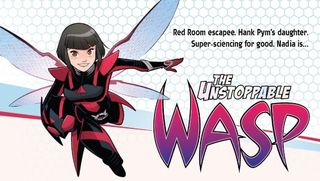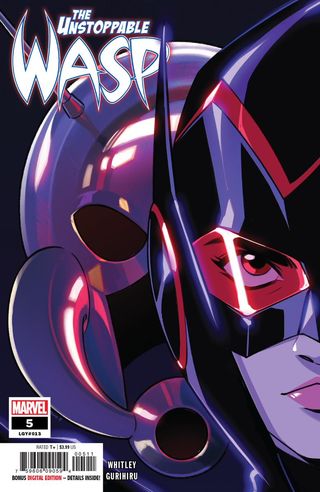Bipolar Disorder
Why Marvel Comics Revealed a Superhero to Be Bipolar
Comic books can help to enlighten and educate readers about mental illness.
Posted February 20, 2019

Since its modern beginnings in the early 1960s, Marvel Comics has always emphasized the flaws, quirks, and human imperfection of its heroes — even the ones who are Norse gods. Some have mere character flaws, such as Peter Parker’s lack of self-confidence and Tony Stark’s abundance of same, but others have deeper psychological problems. Earlier, I wrote about Daredevil’s depression, as well as his mother's experience with post-partum depression, but one Marvel hero with longer-standing mental-health issues is Hank Pym, the original Ant-Man (not to mention Giant-Man, Goliath, and Yellowjacket), who was in a long and tumultuous relationship with Janet van Dyne, the Wasp. (Both characters are now well-known to movie audiences as well.)
Recently, Pym died, and soon thereafter, his long-lost daughter with his first wife (who preceded Janet), Nadia, revealed herself to the world, and took up the mantle of the Wasp, under Janet’s guidance. (The comics and movies don’t exactly line up here: In the movies, the current Wasp is Hope Pym, daughter of Hank and Janet.) A brilliant scientist and trained fighter—having been raised in the Red Room, the same facility that produced Black Widow and the Winter Soldier—Nadia now stars in her own ongoing Marvel title, The Unstoppable Wasp, after a successful eight-issue run in 2017 and a five-issue miniseries, Ant-Man & the Wasp, in 2018 which co-starred Scott Lang, the current Ant-Man.

Since her introduction in 2016, Nadia has injected an enthusiasm and spirit often missing from the Marvel Universe, which is weighed down as it tends to be with impending cosmic disaster and headline-grabbing deaths. Her title emphasizes friendship and teamwork, among superheroes and “civilians” alike, as well as a strong feminist theme of encouraging girls and women to embrace science. (A text piece at the end of each issue highlights a different real-world female scientist.)
But The Unstoppable Wasp covers more serious issues as well, as seen in issues #4 and #5, in which writer Jeremy Whitley and artist Gurihiru, in conjunction with editor Alanna Smith, explore another legacy that Hank Pym passed on to his daughter — his mental illness. As hinted at since her earliest appearances with the Avengers, Nadia is revealed in these issues (and in a New York Times article) to be bipolar, experiencing a manic episode during which she runs herself ragged trying to “fix everything” and clashing with those who love her and want to help her.
In an interview with therapist Tim Stevens for Marvel.com, Whitley discussed the thought process behind highlighting this aspect of Nadia's character:
Marvel.com: How aware of bipolar were you before deciding to incorporate it into the book? How did you set about getting a whole and thorough understanding of it?
Whitley: I was definitely aware of bipolar disorder beforehand. I have friends who have struggled with it in their own lives, either personally or through family members. It wasn't something I knew intimately, but I was very conscious of it.
Before I wrote about it in the book, I wanted to make sure I had a good lock on it. I started by reading up from a strictly medical standpoint. I wanted to have an understanding of what it was clinically and how it functioned. It's often a pitfall in fiction that writers are more interested in a symptom than a disease or disorder and the condition ends up being poorly defined.
Probably more important to me though, was talking to and reading stories from people who have dealt with the condition themselves. It's good to know generally what it looks like, but it's also important to understand what it feels like when you're writing a character. So I consulted quite a bit on this, which you can see if you check out the "special thanks" in these issues.
Whitley also explains why a superhero comic provides a useful forum to explore bipolar disorder:
Marvel.com: As you learned about it, did anything strike you about bipolar disorder that you found unexpected based on your initial knowledge? Anything that really altered how you viewed the disorder?
Whitley: I think the trickiest thing with bipolar disorder was just how cleanly descriptions of experiencing bipolar mania line up with what we expect from a superhero. People who have manic episodes often describe it was feeling like they can do anything, like they're superhuman. When people are experiencing mania they often don't feel the need to eat or sleep. It's an incredible high where things that frequently seem impossible seem simple. The reality of the situation is that mania is the really dangerous part of the disorder, because not sleeping or eating has effects on your ability to process and perform normal tasks. When you're a superhero, the potential to cause harm when you can't concentrate or control your actions is pretty huge.
Whitley is also very careful to make sure that Nadia’s disorder does not define her, but is just one aspect of a complex and developing character:
Marvel.com: There is a danger, I'd imagine, in losing the character to the illness. How do you balance the desire to be honest about Nadia as someone with bipolar without it becoming her entire "story"?
Whitley: It's going to be a balancing act. It's not unlike Storm and her claustrophobia. It's a compelling aspect of the character, but when every story results in Storm being stuck somewhere small and dark, it's a problem. I feel like the '90s X-Men animated series had that issue a bit.
For Nadia, it's something we're going to have to figure out as we go — just like people who deal with the issue in real life. It doesn't go away, but with medication and therapy, it can be better. On the other hand, if Nadia finds herself teleported into the depths of space without her medication, that's a real wrinkle she'll have to deal with. One of our consultants on issue #6 specifically said in a dialog suggestion that "disability will always be a part of you, but it doesn't have to define you," and I think that's an important message to carry on into future UNSTOPPABLE WASP stories.

As we become more aware of mental illness, I appreciate that comic book creators are incorporating it more often into their storylines and the heroes we look up to. Ideally, superheroes should reflect the diversity of their readers, in terms of mental health as well as race, ethnicity, gender, sexual orientation, neurodiversity, and disability, all of which are important not only for representation but also for broader understanding and tolerance.
And if we can get all that in an enjoyable and exciting superhero adventure, as we do in The Unstoppable Wasp, all the better.
You can find The Unstoppable Wasp #4 and #5 at your local comic book store or digitally at Marvel.com or Comixology.
Also check out these trade paperback collections of Nadia's previous adventures:




